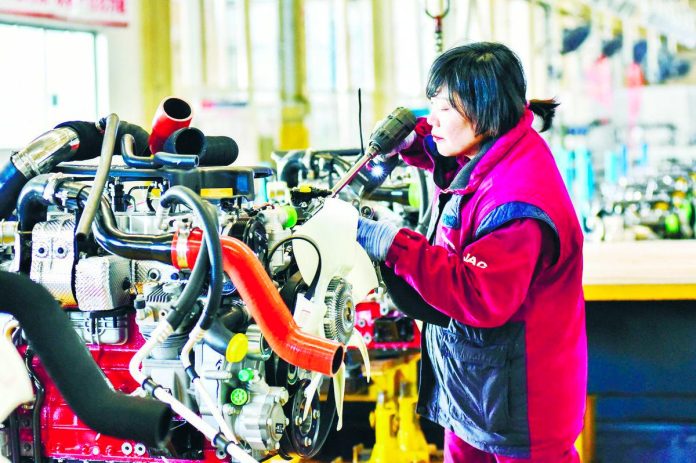AS China’s high-value industrial exports capture a growing share of global markets, the US and EU have pursued separate but complementary policies aimed to push back against this unprecedented threat to Western dominance in international trade and the economic order.
The criticisms levelled by Washington and Brussels to counter the Chinese exports impacting their domestic producers emphasise that China’s state-led and subsidised export-driven economic model has created excess manufacturing capacity, flooding their markets with cheap goods.
Apart from the overcapacity charge,
also commonly featured in the media pronouncements are accusations of unfair trade practices, intellectual piracy, market disruption and national security risks. These concerns have grown as Chinese products – from electric vehicles and batteries to solar panels, wind turbines, ships, electronics, steel, aluminium and a wide range of consumer goods – gain a foothold in Western markets.
This popularity – driven by competitive pricing, quality and superiority over domestic and other rivals – has driven the US and EU nations into record deficits in their accounting trade figures with China.
It has also given rise to demands by anti-China lobbyists for changes to the rules of international trade to ensure Western dominance.
The seriousness of Western concerns is evident in the prominence of alleged Chinese overcapacity in ongoing US-China tariff talks. It also emerged as the most prominent concern of the EU delegation visiting Beijing for a one-day summit to mark the 50th anniversary of China-EU diplomatic relations.
What policy changes can arise from these negotiations and meetings remain to be seen.
Bane for some, boon for others
The consensus amongst independent market analysts and international organisations, such as the International Monetary Fund, is that the charges levelled against China’s export success have little or no basis.
China’s success has been hard-earned, largely driven by its vast, disciplined workforce and adherence, rather than subversion, of the market principles, norms and practices expected of WTO member countries.
The WTO is the premier intergovernmental organisation regulating international trade. In existence since 1995, it has 166 members who are responsible for 98% of global trade and GDP.
A majority of the member countries regard China as a responsible participant while the US, through its recent unilateralism, tariff weaponisation and flaunting of WTO rules is seen as a renegade undermining the authority and relevance of an indispensable arbitrator in the global economic system.
Commentators with experience and knowledge of China’s industrial and manufacturing prowess, including leaders of companies competing in the international markets, testify to the growing dynamism, economies of scale, efficiency and competitive advantages of China’s industrial, manufacturing and hi-tech producers and workers.
Many Western countries have conceded their inability to compete without their governments stepping in to keep out their Chinese rivals. The advances made by China in international markets can be attributed to the following factors:
1. Market-driven competitiveness and innovation
– Efficiency and supply chain advantages: Analysts note that China’s competitive edge, particularly in the new industrial and renewable sectors, such as EVs, solar panels and wind turbines, stems from superior innovation, economies of scale and highly integrated and efficient supply chains rather than from subsidies or any of the other negative factors cited by Western policymakers. They point out that many Western companies are simply unable to compete with their China counterparts on purely market, economic or technical variables.
– Technological advancement: Studies also note that a crucial difference between recent Western and Chinese industrial development is that China has prioritised significant investments in research and development and rapid technological advancement to become key drivers of its production capabilities.
2. Global demand perspective
– Meeting global needs: China’s defenders have asserted that “overcapacity” should be viewed from a global perspective. They argue that the world, especially in the context of climate change, needs a vast amount of green technology, and China is simply meeting this growing global demand efficiently.
– Temporary imbalances: Chinese economists have argued that supply-demand imbalances are a normal part of market mechanisms and are often temporary, with market forces eventually correcting them. The free market economic dogma, long cherished by the West to its own advantage, needs to be upheld rather than abandoned.
Market observers critical of the Western position have also drawn attention to these considerations in the controversy:
1. Challenging definition of “overcapacity” and “non-market”
– Lack of consensus: They point out that there is no universally agreed-upon definition of “overcapacity” or what constitutes “non-market” activity, making the accusations vague, subjective and hypocritical.
– Criticism of Western industrial policies: Also highlighted, especially in relation to the barriers being erected against the entry of Chinese EVs into the American and EU market, is that Western countries have long employed and continue to support similar industrial policies and subsidies in every sector deemed of strategic importance, including in the automotive industry. This suggests a double standard in the criticism against China.
2. Benefits of Chinese exports
– Stimulating global development ripple effects: China’s industrial exports are generally acknowledged to have generated significant economic opportunities for countries around the world, especially in BRICS countries (Brazil, Russia, India, China and South Africa) and new members such as UAE, Egypt, Ethiopia, Iran and Saudi Arabia, through enhanced access to affordable goods, technology transfer, and supply chain integration.
3. Global poverty alleviation
– Chinese exports are seen as providing significant benefits to global poverty alleviation by assisting less developed economies through several mechanisms, including through replication of its highly successful poverty alleviation programmes
– Affordable goods and consumer access: China’s large-scale production, even if in excess of its domestic demand, has led to lower unit costs globally. This translates into more affordable goods for consumers worldwide, particularly in less developed economies where purchasing power is limited.
– Increased access to basic necessities: “Overcapacity” in sectors producing essential goods like clothing, basic electronics, household appliances and agricultural products have made these items more accessible to low-income populations, improving their living standards and addressing their needs.
– Enhanced quality for price: Chinese manufacturers are increasingly producing goods that offer a good balance of quality and affordability, allowing consumers in developing countries to access products that might otherwise be out of reach.
Perhaps the most important outcome of China’s export performance is its role in supplying critical inputs that support economic development in developing countries.
Developing countries rely on imported intermediate and hi-tech inputs for their industrial sectors.
China’s “overcapacity” is providing these inputs at competitive prices and is reducing production costs for local businesses and fostering more rapid industrial growth.
It is also helping usher in a new industrial era, giving BRIC countries a chance to break the established hegemony of the West and its allies.
Conclusion
What we are seeing is that China’s industrial and manufacturing exports, stemming from what
the West alleges as overcapacity, is creating a complex trade-off with net negatives for developed economies and their competing manufacturers and workers.
At the same time, we are seeing mixed but generally net positives for less developed economies and their nascent industries that can become more self-reliant and competitive but only if they can leverage on Chinese imports that provide superior performance to competitors from the West and elsewhere.
Not to be disregarded is that global consumers are benefitting from the lower prices stemming from China’s cost-efficient and value-adding industrialisation.
Meanwhile China’s hi-tech green revolution products are paving a faster transition to a more sustainable future and helping the world meet the climate change challenge.
Lim Teck Ghee’s Another Take is aimed at demystifying social orthodoxy.
Comments: letters@thesundaily.com








